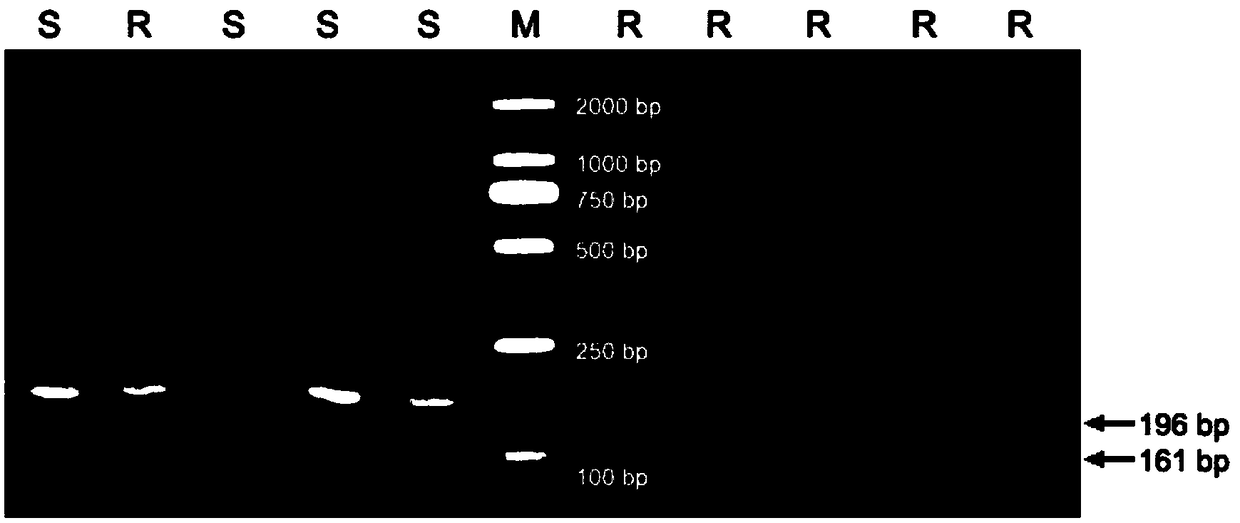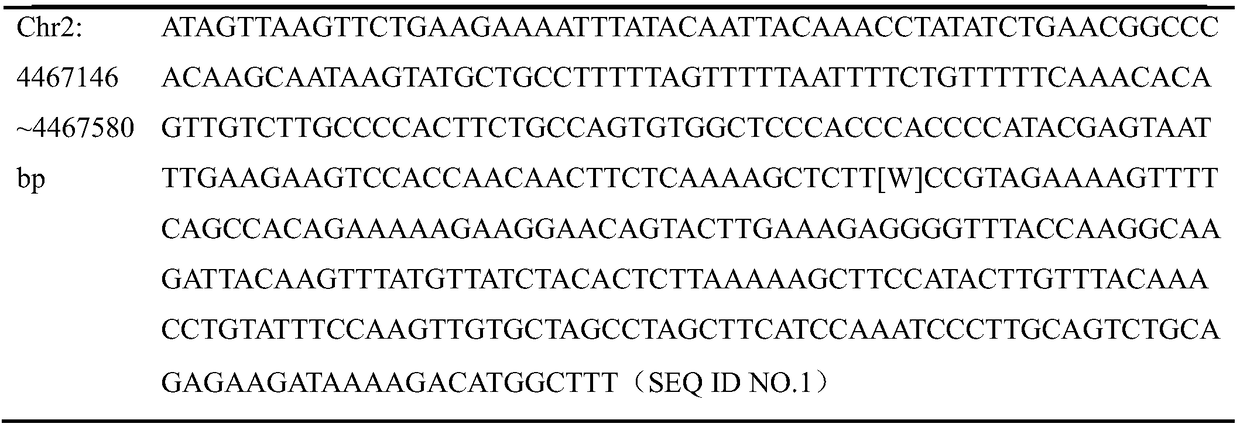Marker site, primer pair and detection kit used for identifying disease resistance/disease susceptibility character of peach trees to meloidogyne incognita and application
A technique for marking sites of root-knot nematode incognita, applied in the determination/inspection of microorganisms, biochemical equipment and methods, DNA/RNA fragments, etc., can solve problems such as unclear key genes and achieve low-cost effects
- Summary
- Abstract
- Description
- Claims
- Application Information
AI Technical Summary
Problems solved by technology
Method used
Image
Examples
Embodiment 1I
[0026] The acquisition of embodiment 1 Indel site
[0027] The present invention uses the hybrid progeny F of 'Honggen Gansu Tao No. 1' and 'Beilei' constructed from the peach germplasm resource nursery of Zhengzhou Institute of Pomology, Chinese Academy of Agricultural Sciences. 1 F 2 The germplasm of 250 selfing populations was used as samples, which were inoculated with Meloidogyne incognita and the disease resistance index was investigated. Then 20 disease-resistant and 20 high-susceptibility germplasms were selected to construct mixed gene pools, and the sample DNA was extracted by conventional CTAB method, and the parental 'Honggengansutao 1' and 'Beilei' were sequenced by Illumina HiSeq 2000 sequencer. , resistant mixed pool, susceptible mixed pool and F 1 A total of 5 samples of DNA were sequenced, and 47.58Gb of data was obtained, covering an average of 95.50%-96.49% of the peach genome, and the average sequencing depth was between 38.04× and 49.18×. According to t...
Embodiment 2
[0028] Example 2 The method for identifying peach tree resistance to root-knot nematode incognita using the PCR marker developed by the polymorphic Indel site
[0029] 1. DNA extraction
[0030] The DNA of the peach sample tissue to be tested was extracted by the conventional CTAB method, and the RNA was removed. The total volume of the DNA sample was not less than 15 μl. Measure the OD value of the DNA sample at 260nm and 280nm with a UV photometer, and calculate the DNA content and OD 260 / 280 ratio. DNA sample purity OD 260 / 280 The value should be between 1.8 and 2.0, and the concentration should be diluted to 50ng / μl.
[0031] 2. Design primers
[0032] The primers were designed according to the 200 bp sequence upstream and downstream of the 35 bp deletion sequence site at the 4,467,346-4,467,380 position of chromosome 2 of the peach genome (see Table 1 for the specific nucleotide sequence).
[0033] Table 1 35bp Indel flanking sequence information
[0034]
[0035...
Embodiment 3
[0047] Example 3 Verification of the phenotypic traits of peach germplasm using the PCR markers developed at the Indel locus of peach tree resistance to root-knot nematode incognita
[0048] 1. Selection of experimental materials
[0049] The hybrid progeny F of 'Honggen Gansu Tao No. 1 F 2 250 self-bred population germplasms were used as experimental materials.
[0050] 2. An identification method for phenotypic prediction using markers developed at Indel loci associated with peach tree resistance to root-knot nematode incognita
[0051] Using a pair of PCR primers developed from the 200 bp upstream and downstream sequences of the 2nd chromosome of the peach genome of the present invention, respectively, to identify the disease resistance / susceptibility traits of 250 self-bred population test materials, the specific identification method refers to The method of embodiment 2.
[0052] 3. Prediction of phenotype by typing results in selfing populations
[0053] Table 4 and...
PUM
 Login to View More
Login to View More Abstract
Description
Claims
Application Information
 Login to View More
Login to View More - R&D
- Intellectual Property
- Life Sciences
- Materials
- Tech Scout
- Unparalleled Data Quality
- Higher Quality Content
- 60% Fewer Hallucinations
Browse by: Latest US Patents, China's latest patents, Technical Efficacy Thesaurus, Application Domain, Technology Topic, Popular Technical Reports.
© 2025 PatSnap. All rights reserved.Legal|Privacy policy|Modern Slavery Act Transparency Statement|Sitemap|About US| Contact US: help@patsnap.com



